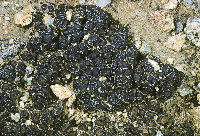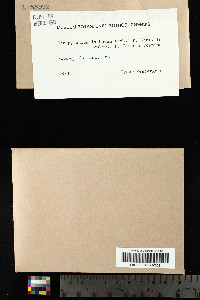
Consortium of Lichen Herbaria
- building a Global Consortium of Bryophytes and Lichens as keystones of cryptobiotic communities -
- Home
- Search
- Images
- Species Checklists
- US States: O-Z >
- US National Parks
- Central America
- South America
- US National Parks
- Southern Subpolar Region
|
|
|
|
Family: Verrucariaceae
[Catapyrenium lacinulatum (Zahlbr.) Wetmore, moreCatapyrenium lacinulatum var. lacinulatum (Ach.) Breuss, Catapyrenium lacinulatum var. latisporum Breuss, Placidium lacinulatum (Ach.) Breuss, Placidium lacinulatum var. lacinulatum (Ach.) Breuss, Placidium lacinulatum var. latisporum (Breuss) Breuss] |
Nash, T.H., Ryan, B.D., Gries, C., Bungartz, F., (eds.) 2002. Lichen Flora of the Greater Sonoran Desert Region. Vol 1. Thallus: squamulose squamules: c. 3-8 mm wide, c. 0.3-0.5 mm thick; roundish to deeply lobed, discrete or contiguous, flat and closely adnate to the substrate or loosely adnate with ± raised and wavy margins and then with a crispy appearance, ± overlapping, sometimes forming cushion-like aggregates upper surface: pale to dark brown, dull, epruinose or slightly pruinose upper cortex: 40-80 µm thick; epinecral layer: lacking or very thin medulla: white, with many spherical cells (8-14 µm in diam.); algal layer: c. 60-100 µm thick lower cortex: indistinct or lacking, composed of ± densely aggregated, roundish cells; rhizohyphae: colorless, 4-5 µm in diam. lower surface: pale or darkening, rhizinate; rhizines: few to many per squamule, pale or brown, simple or ± branched, partly anastomosing, main strands up to 0.3 mm thick and more than 15 mm long (but often smaller and inconspicuous!) Perithecia: broadly pyriform to subglobose, up to 0.6 mm broad and ± bulging on the underside of the squamules; perithecial wall: colorless or brownish, rarely darkening (in overmature specimens and certain varieties): periphyses: 25-35 x 2.5-3.5 µm asci: cylindrical, 65-80 x 12-17 µm, 8-spored ascospores: uniseriate, ellipsoid, c. 12-16 x 6-7.5 µm (in the typical form; see below) Pycnidia: laminal, immersed conidia: rather variable in shape (ellipsoid-oblong to subcylindrical to shortly cylindrical), 3-5 x 1.3-2 µm Spot tests: all negative Secondary metabolites: none detected. Substrate and ecology: soil (mostly fine-grained) in open, dry areas from low to high elevations World distribution: Europe, Asia, northern Africa, the Americas in temperate latitudes Sonoran distribution: very common and frequent in Arizona, California, Baja California, Baja California Sur, Chihuahua and Sonora. Notes: Placidium lacinulatum is anatomically very similar to P. squamulosum but differs in being rhizinate. The rhizines vary considerably in size and number from few and indistinct to large and conspicuous but are always visible by careful investigation (of wetted specimens as the rhizines easily break off in dry condition). They may originate from most of the underside or centrally crowded. The species is very variable according to thallus form, pigmentation of exciple and underside, and shape and size of ascospores and conidia and may represent several varieties. |
|
|
|
Powered by Symbiota










































































































